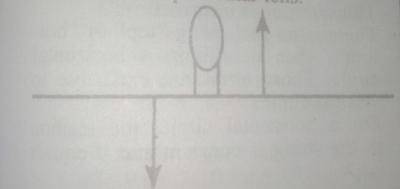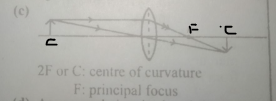
(a) State the condition for light ray incident on a concave mirror to reflect through the principal focus of the mirror.
(b) Explain spherical aberration as a defect of curved mirrors
(c) The diagram above illustrates an image formed when an object is placed in front of a particular lens. Redraw the diagram and indicate the center of curvature, C, principal focus, F, and the principal axis. ( SEE THE DIAGRAM ABOVE)
(d) What is meant by accommodation in connection to the human?
(e) State quantitatively, the (i) values of the near and far point of a normal eye. (ii) Use the answer in 10c(i) to determine the change in optical power of the normal human eye when reading a book and viewing the sky.[lens-to-retina distance = 2.5 cm].

(a) The incident light rays must be parallel and close to the principal axis
(b) Spherical aberration as a defect of curved mirrors: When a wide parallel beam is incident on a spherical mirror, it is not brought to the same focus. This makes the image distorted.
(c) SEE THE DIAGRAM ABOVE
(d) Accommodation is the ability of the eyes to alter its focal length to form a clear image
(e) Quantitatively, (i) far point = infinity, Near point = 25 cm
P\(_{near point}\) = \(\frac{1}{f}\) = \(\frac{1}{u}\) + \(\frac{1}{v}\)
(ii) for near point, u = 0.25 m
P\(_{near point}\) = \(\frac{1}{f}\) = \(\frac{1}{0.25}\) + \(\frac{1}{v}\)
similarly, for far point, u = infinity(∞)
P\(_{far point}\) = \(\frac{1}{f}\) = \(\frac{1}{u}\) + \(\frac{1}{v}\)
P\(_{far point}\) = \(\frac{1}{∞}\) + \(\frac{1}{v}\)
= 0 + \(\frac{1}{v}\)
So, change in optical power
ΔP = P\(_{near point}\) - P\(_{far point}\)
ΔP = 4 + \(\frac{1}{v}\) - \(\frac{1}{v}\)
ΔP = 4 dioptres.
Contributions ({{ comment_count }})
Please wait...
Modal title
Report
Block User
{{ feedback_modal_data.title }}